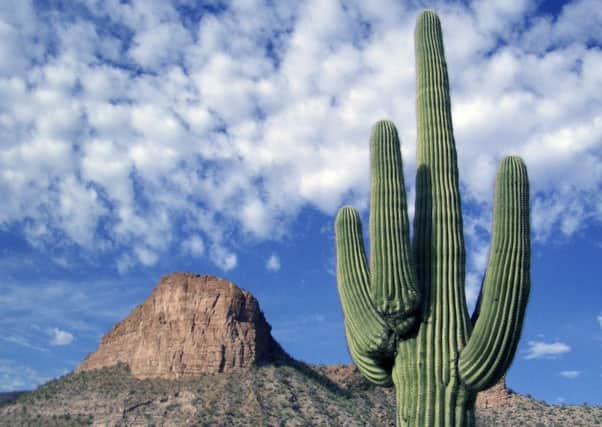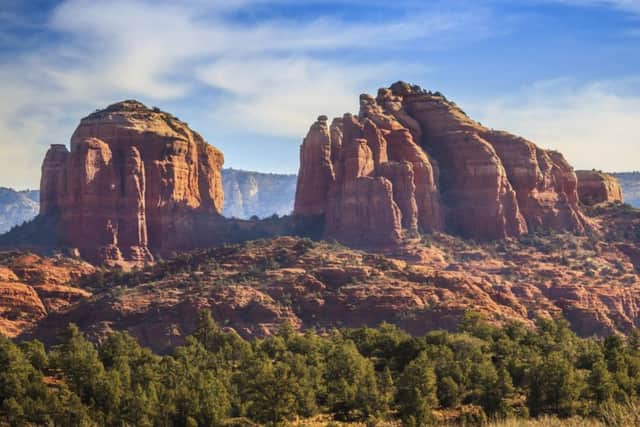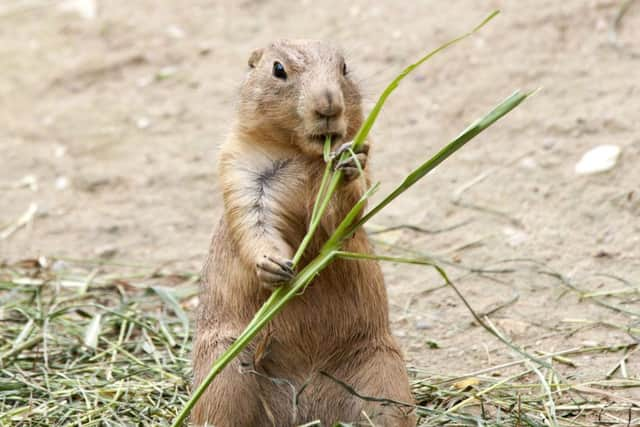Travel: Arizona is out of this world
This article contains affiliate links. We may earn a small commission on items purchased through this article, but that does not affect our editorial judgement.


Early spring in Arizona is the perfect time to discover the state’s spectacular natural wonders. “Oh isn’t it adorable. It looks just like a fairy,” said a beaming elderly lady as an iridescent humming bird fluttered within inches of her nose. I was visiting the Arizona-Sonora Desert Museum, a world renowned natural habitat zoo near Tucson in southern Arizona, and the hummingbirds were on fine form. Darting through the air chasing floating seeds and having mid-flight squabbles that resembled miniature Spitfire battles, their aerial acrobatics captivated everybody. The same couldn’t be said of the big desert cats. In the noon heat it was siesta time, and all I could see was a mountain lion’s tail dangling lazily from a cave. The best time to see the mammals is early morning as they race about in the cool temperatures. Happily, you can always rely on prairie dogs for a good show – basking in the sun munching carrots, their cute pot bellies sticking out.
The Sonoran Desert is home to one of the most bio diverse desert environments on earth and for residents of Tucson, the beautiful landscapes offer endless recreational opportunities. One of the most popular after-work activities is a sunset drive over the Gates Pass, where a mountain road gently loops around the Tucson Mountains and descends into the Saguaro National Park. Scenic lookouts line the road and 150 miles of trails weave through a surreal landscape of giant saguaro cacti forests. With upturned arms exceeding 20m in height, these jolly green giants are held in great affection in Arizona and the sight of them framed against fiery desert sunsets is a magical experience of which the locals never tire.
Advertisement
Hide AdAdvertisement
Hide AdAn invigorating outdoors lifestyle coupled with the sunniest climate in the USA has made Arizona a magnet for city dwellers in search of a better life. With 22 National Parks and dozens more smaller State Parks to explore, it’s difficult for visitors to know where to begin, but Sedona – which regularly features on the USA’s most beautiful places list – is an excellent choice. The drive up from Phoenix has all the exhilaration of a classic American road trip. North of the city, saguaro forests spill over the hilltops and as the highway climbs in altitude, views open up of sweeping canyons and jagged mountains shimmering in the heat. Near Camp Verde I left the highway and within minutes, Sedona’s famous “red rocks” came into view. Rocks is a misnomer; these orange sandstone crags tower hundreds of feet above the landscape, and as I drove past these remarkable natural formations, I could barely keep my eyes on the road. I was sorely tempted to jump out of the car and embark on a hike but although it was just 4pm, my jetlagged stomach was crying out for dinner.


Instead, I drove on to Sedona’s town centre and found a cheerful cafe overlooking a ravine. There, I took a seat on the terrace and sat back to enjoy the magnificent view of Cathedral Mountain stained blood red by the setting sun. Against the cliffs I spotted a lone eagle gracefully circling in the thermals.
There was a whiff of incense in the air – Sedona is one of America’s most popular New Age centres – and, despite being distracted by a particularly delicious peach cobbler, I could fully appreciate Sedona’s spiritual credentials. After sunset, I drove on to Flagstaff and shivered as I stepped out of the car. At 2,100 metres altitude, Flagstaff is a good 15 degrees cooler than Phoenix and I was glad to enter the cosy Weatherford Hotel, a delightful historic inn dating to 1900. Dizzy with the rarefied mountain air, I quickly crashed out and slept like a stone, oblivious to the creaking floorboards that make this listed building a hit with ghost hunters.
Surrounded by pine forests and flanked by the snow-capped San Francisco Peaks, Flagstaff has a magnificent setting and next morning, in the spring sunshine, I headed out to explore some local beauty spots. My first port of call was Walnut Canyon National Monument, ten miles east of town. Here, the ancient Sinagua Native Americans built dramatic villages on limestone cliff faces utilising natural overhangs as roofs. A well-maintained trail leads down into the canyon where soft breezes rustle in the pines and strange bird calls echo across the canyon. It’s one of those mystical ancestral places that forces visitors into respectful contemplation, and the Hopi descendants of the Sinagua still come here to collect healing herbs and offer prayers.
Flagstaff’s outdoor attractions are not restricted to the daytime. The clear mountain air is ideal for stargazing, and in 2001 Flagstaff became the world’s first dark sky city. On top of a hill in the west of town lies the Lowell Observatory where Pluto was discovered in 1930. Conditions couldn’t have been more perfect. In the crisp clear sky, I could see the Milky Way sparkling in a giant arc over the city. In the garden I joined some enthusiastic astronomy students who had set up telescopes pointing at various objects in the night sky. The piece de resistance was Jupiter, which had just passed its closest approach to Earth. Through the telescope I could clearly see the planet’s dramatic stripes and the four Galilean moons sparkling with diamond bright clarity – truly an awe-inspiring sight.


After an exhausting few days exploring Arizona’s magnificent National Parks, I returned to Phoenix to relax in the chilled-out university suburb of Tempe before the long journey home. There, I headed over to the Desert Botanic Garden, one of the world’s great collections of desert plants. The garden is located in Papago Park, a beautiful wilderness of red sandstone hills and giant saguaro groves. The spring desert in bloom displays were just beginning, and in the garden kaleidoscopic butterflies were fluttering amongst the pink feathery flowers. At a terrace café I sat down in the sublime warm sunshine and within minutes, quails appeared from the undergrowth, their strange head feathers bobbing. Hot on their heels a pair of ground squirrels scampered around, while a jack rabbit with huge elongated ears looked on from behind a saguaro. When a giant swallowtail butterfly floated by, I had the odd feeling I’d gate-crashed a Walt Disney film. The local people are so lucky to enjoy this wonderful climate. For 85 per cent of the year they bask in glorious sunshine and coming from a rain-soaked winter back home, that seems a priceless gift. Florida may have usurped the title, but Arizona is America’s true sunshine state.
• British Airways operates the only direct flights between the UK and Phoenix, www.ba.com
For more on Phoenix, www.visitphoenix.com; for Tucson, www.visittucson.org and for Flagstaff, www.flagstaffarizona.org